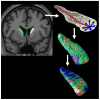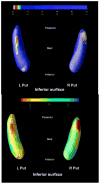Differential putaminal morphology in Huntington's disease, frontotemporal dementia and Alzheimer's disease
- PMID: 22990433
- PMCID: PMC4113021
- DOI: 10.1177/0004867412457224
Differential putaminal morphology in Huntington's disease, frontotemporal dementia and Alzheimer's disease
Abstract
Objective: Direct neuronal loss or deafferentation of the putamen, a critical hub in corticostriatal circuits, may result in diverse and distinct cognitive and motoric dysfunction in neurodegenerative disease. Differential putaminal morphology, as a quantitative measure of corticostriatal integrity, may thus be evident in Huntington's disease (HD), Alzheimer's disease (AD) and frontotemporal dementia (FTD), diseases with differential clinical dysfunction.
Methods: HD (n = 17), FTD (n = 33) and AD (n = 13) patients were diagnosed according to international consensus criteria and, with healthy controls (n = 17), were scanned on the same MRI scanner. Patients underwent brief cognitive testing using the Neuropsychiatry Unit Cognitive Assessment Tool (NUCOG). Ten MRI scans from this dataset were manually segmented as a training set for the Adaboost algorithm, which automatically segmented all remaining scans for the putamen, yielding the following subset of the data: 9 left and 12 right putamen segmentations for AD; 25 left and 26 right putamina for FTD; 16 left and 15 right putamina for HD; 12 left and 12 right putamina for controls. Shape analysis was performed at each point on the surface of each structure using a multiple regression controlling for age and sex to compare radial distance across diagnostic groups.
Results: Age, but not sex and intracranial volume (ICV), were significantly different in the segmentation subgroups by diagnosis. The AD group showed significantly poorer performance on cognitive testing than FTD. Mean putaminal volumes were HD < FTD < AD ≤ controls, controlling for age and ICV. The greatest putaminal shape deflation was evident in HD, followed by FTD, in regions corresponding to the interconnections to motoric cortex.
Conclusions: Differential patterns of putaminal atrophy in HD, FTD and AD, with relevance to corticostriatal circuits, suggest the putamen may be a suitable clinical biomarker in neurodegenerative disease.
Figures






Similar articles
-
Putaminal volume in frontotemporal lobar degeneration and Alzheimer disease: differential volumes in dementia subtypes and controls.AJNR Am J Neuroradiol. 2009 Sep;30(8):1552-60. doi: 10.3174/ajnr.A1640. Epub 2009 Jun 4. AJNR Am J Neuroradiol. 2009. PMID: 19497964 Free PMC article.
-
More atrophy of deep gray matter structures in frontotemporal dementia compared to Alzheimer's disease.J Alzheimers Dis. 2015;44(2):635-47. doi: 10.3233/JAD-141230. J Alzheimers Dis. 2015. PMID: 25322925
-
Striatal morphology correlates with frontostriatal electrophysiological motor processing in Huntington's disease: an IMAGE-HD study.Brain Behav. 2016 Jul 27;6(12):e00511. doi: 10.1002/brb3.511. eCollection 2016 Dec. Brain Behav. 2016. PMID: 28031992 Free PMC article.
-
Clinical Neurology and Epidemiology of the Major Neurodegenerative Diseases.Cold Spring Harb Perspect Biol. 2018 Apr 2;10(4):a033118. doi: 10.1101/cshperspect.a033118. Cold Spring Harb Perspect Biol. 2018. PMID: 28716886 Free PMC article. Review.
-
Alzheimer's disease and the frontotemporal dementias: contributions to clinico-pathological studies, diagnosis, and cognitive neuroscience.J Alzheimers Dis. 2013;33 Suppl 1:S211-7. doi: 10.3233/JAD-2012-129038. J Alzheimers Dis. 2013. PMID: 22766737 Review.
Cited by
-
Disrupted Dynamic Functional Connectivity in Distinguishing Subjective Cognitive Decline and Amnestic Mild Cognitive Impairment Based on the Triple-Network Model.Front Aging Neurosci. 2021 Sep 17;13:711009. doi: 10.3389/fnagi.2021.711009. eCollection 2021. Front Aging Neurosci. 2021. PMID: 34603006 Free PMC article.
-
The power of neuroimaging biomarkers for screening frontotemporal dementia.Hum Brain Mapp. 2014 Sep;35(9):4827-40. doi: 10.1002/hbm.22515. Epub 2014 Mar 31. Hum Brain Mapp. 2014. PMID: 24687814 Free PMC article.
-
Neuroimaging predictors of brain amyloidosis in mild cognitive impairment.Ann Neurol. 2013 Aug;74(2):188-98. doi: 10.1002/ana.23921. Epub 2013 Sep 10. Ann Neurol. 2013. PMID: 23686534 Free PMC article.
-
Differential diagnosis of neurodegenerative dementias with the explainable MRI based machine learning algorithm MUQUBIA.Sci Rep. 2023 Oct 13;13(1):17355. doi: 10.1038/s41598-023-43706-6. Sci Rep. 2023. PMID: 37833302 Free PMC article.
-
The Australian, US, Scandinavian Imaging Exchange (AUSSIE): an innovative, virtually-integrated health research network embedded in health care.Australas Psychiatry. 2014 Jun;22(3):260-265. doi: 10.1177/1039856214523494. Epub 2014 Feb 19. Australas Psychiatry. 2014. PMID: 24554532 Free PMC article.
References
-
- Alexander GE, Delong MR, Strick PL. Parallel organisation of functionally segregated circuits linking basal ganglia and cortex. Ann Rev Neurosci. 1986;9:357–381. - PubMed
-
- Aylward E, Sparks BF, Field KM, Yallapragada V, Shpritz BD, Rosenblatt A, Brandt J, Gourley LM, Liang K, Zhou H, Margolis RL, Ross CA. Onset and rate of striatal atrophy in preclinical Huntington disease. Neurology. 2004;63:66–72. - PubMed
Publication types
MeSH terms
Grants and funding
LinkOut - more resources
Full Text Sources
Medical

